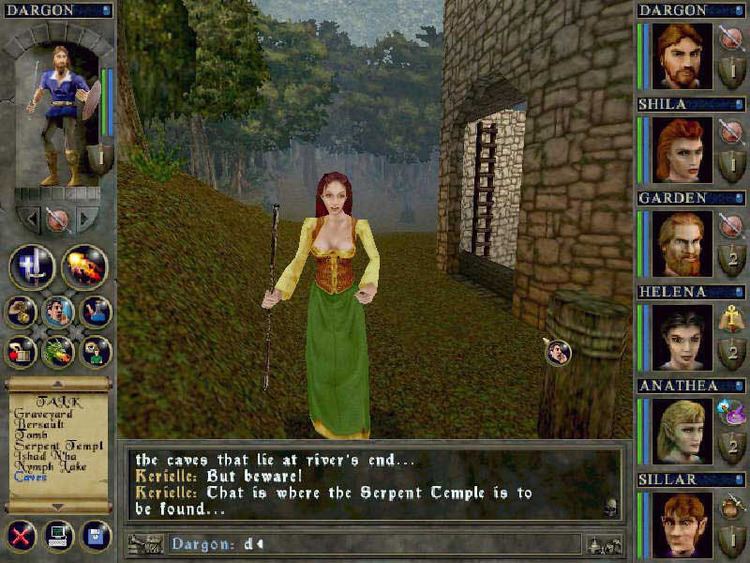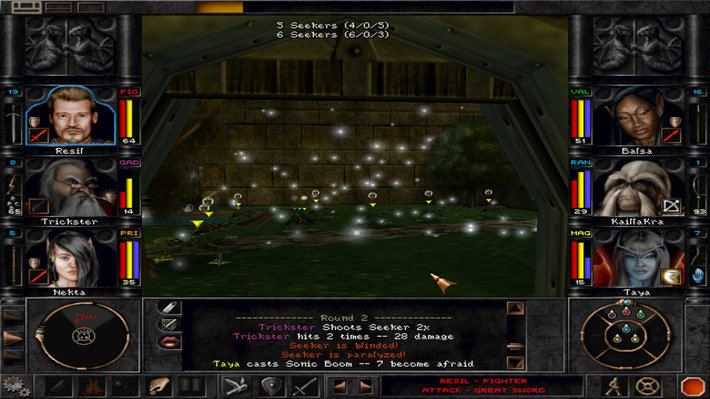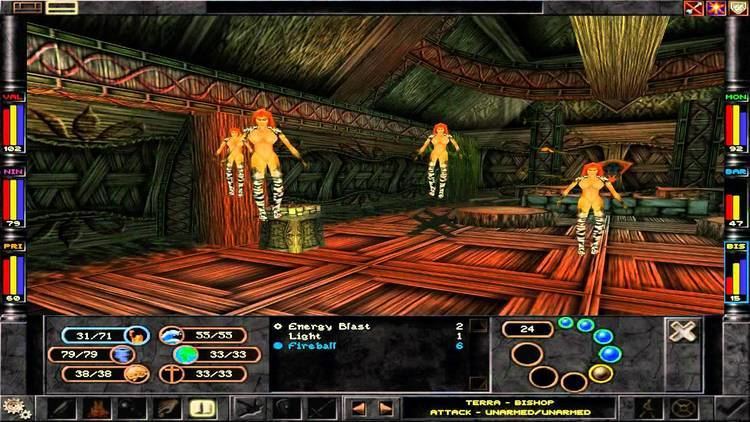9.2 /10 1 Votes
4.7/5 GOG Producer(s) Linda Currie Developer Sir-Tech | 9/10 Steam 9.1/10 GameSpot Writer(s) Brenda Brathwaite Initial release date 14 November 2001 Designer Brenda Romero | |||||||||||||||||||||||||||||||||
 | ||||||||||||||||||||||||||||||||||
Publisher(s) Sir-TechNight Dive Studios (digital) Programmer(s) Derek BelandAlex Meduna Artist(s) Kristofer EgglestonJames Ferris Similar Wizardry games, Sir-Tech games, Role-playing video games | ||||||||||||||||||||||||||||||||||
Wizardry 8 pc review the importance of wizardry
Wizardry 8 is the eighth and final title in the Wizardry series of role-playing video games by Sir-Tech Canada. It is the third in the Dark Savant trilogy, which includes Wizardry VI: Bane of the Cosmic Forge and Wizardry VII: Crusaders of the Dark Savant. It was published in 2001 by Sir-Tech, and re-released by Night Dive Studios on GOG.com and Steam in 2013.
Contents
- Wizardry 8 pc review the importance of wizardry
- Wizardry 8 expert any speedrun 2 58 47
- Development
- Story
- Beginnings
- Main Story
- Endings
- Gameplay
- Reception
- User improvements
- References

Wizardry 8 expert any speedrun 2 58 47
Development

Wizardry 8 was published nine years after the previous title, Wizardry VII: Crusaders of the Dark Savant in 1992, and five years after the completion of Wizardry VII's Windows 95 version, titled Wizardry Gold in 1996.

David W. Bradley had been the chief designer of Wizardry VI and VII, but he was not involved in the design of this game. After Bradley's departure, Sir-Tech outsourced the development of what-would-be Wizardry 8: Stones of Arnhem to DirectSoft, their distributor in Australia. However this attempt failed and they relaunched the project entirely with Sir-Tech Canada. Linda Currie is credited as producer of Wizardry 8. Brenda Brathwaite was the game's lead designer.

In spite of a 'final save' after the final battle, Sir-Tech announced that they had no plans to make a sequel. The company later went out of business in 2003.
Story
The ultimate aim of the game is to collect three artifacts and to place each on its pedestal in the final zone. This allows ascension to the Cosmic Circle, where the player becomes a god. There are four main paths to proceed through the game: Allying with either the T'Rang or Umpani, allying with both, or else being enemies with both. In addition, players can also choose to gain friendship with the Rattkin or the Trynnie, and players can choose whether or not to ally with the Rapax, Rattkin Razuka or Mook (though none of these choices affect the ending of the game).
Beginnings
As with the first two installments of the Dark Savant trilogy, Wizardry 8 has multiple beginnings that continue from the previous games' multiple endings. There are five beginnings in all. Characters imported from Wizardry VII start in the Umpani stronghold or in the T'Rang stronghold, depending on the player's alliance. If the imported characters failed their mission in Wizardry VII, resulting in their banishment into space, they are given a message that they are "still floating in endless darkness" and are not allowed to start their adventure in Wizardry 8. New characters or unallied characters imported from the previous game start in the Higardi monastery.
In the final area of Wizardry VII, the Isle of Crypts, the party has a choice to tell their enigmatic partner, Vi Domina, whether or not they have a way to leave the planet Guardia. They have the option of telling the truth and informing her that they found a spaceship, or lying and saying that they have no way to leave. If the party follows the path of truth, the Girl and Globe endings are open to them. If they lie, the Umpani, T'Rang and Globe endings are open to them.
Main Story
Whatever the circumstances of the party's entrance into the world of Dominus, the goal of finding the three artifacts needed to ascend to godhood remains unchanged. They must find the Astral Dominae, the key to life and which is held by the Dark Savant, the Destinae Dominus, the key to knowledge and which was stolen by the thief Marten, and the Chaos Moliri, the key to change and which is held by the Mook.
The party ends up procuring each of these artifacts through different means: they acquire the Astral Dominae when the Rattkin, who came to Dominus on the heels of the Umpani and the T'Rang on a stolen T'Rang ship, rob the device from the Savant and sell it to the party. The Chaos Moliri arrives in their hands once they've allied with the Umpani and/or the T'Rang, who provide the party with a letter that allows them access to the Mook compound, and then steal the device from the Mook (alternatively, they may murder either the Umpani or T'Rang leader, steal the alliance letter from their corpse, and then enter into an alliance with the Mook under false pretenses). Finally, they follow the footsteps of the thief Marten to the Sea Caves, and his ghost entrusts them with the safety of the Destinae Dominus.
Once all three artifacts are in their possession, the party goes to Ascension Peak to begin the path to godhood, only to find the path blocked off by the Rapax, a warlike race of demonic beings. After travelling to their castle and becoming Rapax Templars, which involves sleeping with (and impregnating) their demon goddess, the way to the Peak is finally open. The party climbs to the very top of Ascension Peak, places the three objects in their receptacles, and enters the Cosmic Circle on the heels of the Savant. It is not required for the party to join with the Rapax, as they may set a portal on Ascension Peak before the Rapax block the path, and can teleport in later as they wish.
In the Cosmic Circle, the Dark Savant has already arrived and is speaking with Aletheides, the cyborg that the party either joins or follows to planet Guardia in Wizardry VII, depending on their choices in Wizardry VI. He demands to know where the Cosmic Lords are, but Aletheides simply says that they are gone. The Dark Savant kills him in anger, and the party approaches. When they do, they find that the Cosmic Forge back in the Circle where it should be (its theft is detailed in Wizardry VI).
The Dark Savant reveals that he is, in fact, Phoonzang, the enigmatic god figure from both Wizardry VII and 8, and a former Cosmic Lord. The other Cosmic Lords cast him down for trying to share the knowledge of the universe with mortals (e.g., humans, T'Rang, elves), and he was forced to become part machine to continue to live past a normal man's lifespan. He then offers the party the chance to join him, and become Cosmic Lords along with him.
Endings
The party, at this point, has three choices which lead to different endings:
Gameplay
Wizardry 8 is played from a "first person" perspective. Movement is fluid, whereas in previous Wizardry games the party moved in discrete "tiles" (i.e. the party would move one "tile" forward, backwards, or sideways, and could only turn in increments of 90 degrees).
For the first time in the Wizardry series, players can see enemies approaching instead of having them pop up randomly. Combat is turn-based, although a continuous-phase mode can be toggled. Because combatants are free to move during combat, some disadvantages of the combat engine can quickly become apparent. Fights with more than ten enemies can become tedious, while spells that cause fear can cause the enemies to run away, even though the player's party is still flagged as being in combat. Due to the way enemies tend to surround the party, it is often necessary to retreat into nooks and crannies in the terrain in order to prevent being flanked.
Wizardry 8 uses different statistics than the previous games, necessitating conversions from the upper limit of 18 to the new upper limit of 100.
Each race and class has a balance of strengths and weaknesses. The various races and classes are designed to be balanced so that a wide variety of parties can be playable. Characters may change their class as they advance, allowing a variety of combinations.
Monsters are scaled to the party level; higher level parties will face different sets of monsters than a lower level party in the same area. The scaling is limited to allow variation in difficulty.
For players seeking a more difficult challenge, Sir-Tech brought back an option to play using rules from the early Wizardries - the "Iron Man Mode". In this "permadeath" mode, players are not allowed to save the game; instead the game is automatically saved when the player quits. As a result, a death cannot be trivially undone by a simple "Restore Game".
There are many secret areas, including "retro dungeons". Retro Dungeon refer to the look of the dungeons in the original Wizardry (Proving Grounds of the Mad Overlord). Instead of vast open views, players are greeted with a solid, traditional grid-based dungeon. Spinners, traps and teleporters are used.
Reception
Wizardry 8 received "generally favorable reviews" according to the review aggregation website Metacritic.
The game won multiple awards, including RPG of the Year from Computer Gaming World. Giving the game two separate awards, GameSpot said, "Wizardry 8 is an excellent role-playing game in and of itself, which is why it deserves GameSpot's Best Single-Player RPG of the Year award and why it has earned a place in the Top 10 PC Games of the Year."
Additional awards include:
User improvements
Despite the closing of the development studio, Sir-Tech continued to provide support and created several patches or upgrades for the game for years after release. This support was provided with the collective help of the Wizardry 8 Developer(s) who donated their time. Fans of the series have continued the efforts, providing editors, mods and game info.
